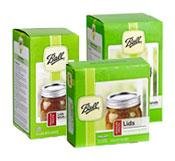The Internet is picking up where granny left off in passing down tips on home canning. (Courtesy Jarden Home Brands)
CHICAGO, July 1 (UPI) -- Juicy, red tomatoes right off the vine and sweet strawberries that melt on the tongue -- fresh fruits and vegetables from the garden or a nearby farm are one of the joys of summer that disappear all too quickly.
Grandma, or perhaps great-grandma, knew the clear glass jars filled with tomatoes, pickles, beets, peaches and strawberry jam that lined their shelves were more than just a hedge against hunger. They knew a spoonful of June's strawberry jam can warm the heart when January's cold winds start to blow.
Canning and preserving to capture the harvest at its peak is making a comeback in the United States with people ranging from 20-something heritage-brand obsessed hipsters who frequent urban farmers markets or grow tomatoes on the balcony to 40ish suburban moms with a garden behind the swing-set.
The trend appears to be an outgrowth of the increasing desire for sustainable, locally grown produce, or at least the desire for a tomato that doesn't taste like cardboard.
Thanks to the proliferation of farmers markets in cities and small towns across the country, nearly everyone -- with the exception of those in urban food deserts -- can generally find the good stuff, at least during the summer.
Jarden Home Brands, which makes Ball jars and other home canning products, said U.S. Department of Agriculture statistics show the number of farmers markets has increased by nearly 20 percent in the past year as consumers seek locally grown foods. There are also approximately 90 million U.S. households planting gardens this year, according to the National Gardening Association.
Beets have become trendy and local farmers markets are often part of the local social scene. Restaurants have increased the cache of preserves and pickles that once seemed more suited to a humble farm meal than a gourmet night out on the town.
Some of the nation's leading chefs, including Thomas Keller and Michael Symon, offer recipes for preserves and pickles in their cookbooks.
Williams-Sonoma has caught on to the trend, offering canning equipment as part of its new Agrarian line that also features impossibly darling chicken coops and other equipment for the upscale farmer.
The art of preserving and canning was once passed down generation to generation but that declined as more women entered the workforce, leaving less time and perhaps inclination for some of the domestic arts pursued by their mothers. The Internet and social media is stepping up to fill the education gap, said Lauren Devine-Hager, a test kitchen scientist and editor of the "Ball Complete Book of Home Preserving."
"There are a lot of people who are interested [in canning] but don't know where to get started," Devine-Hager told UPI, especially younger people. More than half of Ball's Facebook community is less than 44 years of age.
"We are seeing, for the younger canners, they love being able to share what they're doing, feel part of the community," she said. The Facebook page offers a place for them to ask questions and make comments, Devine-Hager said.
Jam appears to be the drawing for most visitors to the company's Web site, FreshPreserving.com, which offers recipes and step-by-step canning advice. Jam recipes comprise 80 percent of all recipe page views on FreshPreserving.com, the company said.
Jarden Home Brands is hosting the 2nd Annual National Can-It-Forward Day July 14, featuring a Web cast from Minnetrista in Muncie, Ind., the original homestead of the Ball family, to teach "foodies the simplicity of fresh preserving whether creating a delicious jam, pickling fresh cucumbers or canning local tomatoes," the company said in a release.
"People think the canning process is very hard and difficult to do ... but I like to say it really is just one step beyond cooking," Devine-Hager said. "It really is a simple process."















